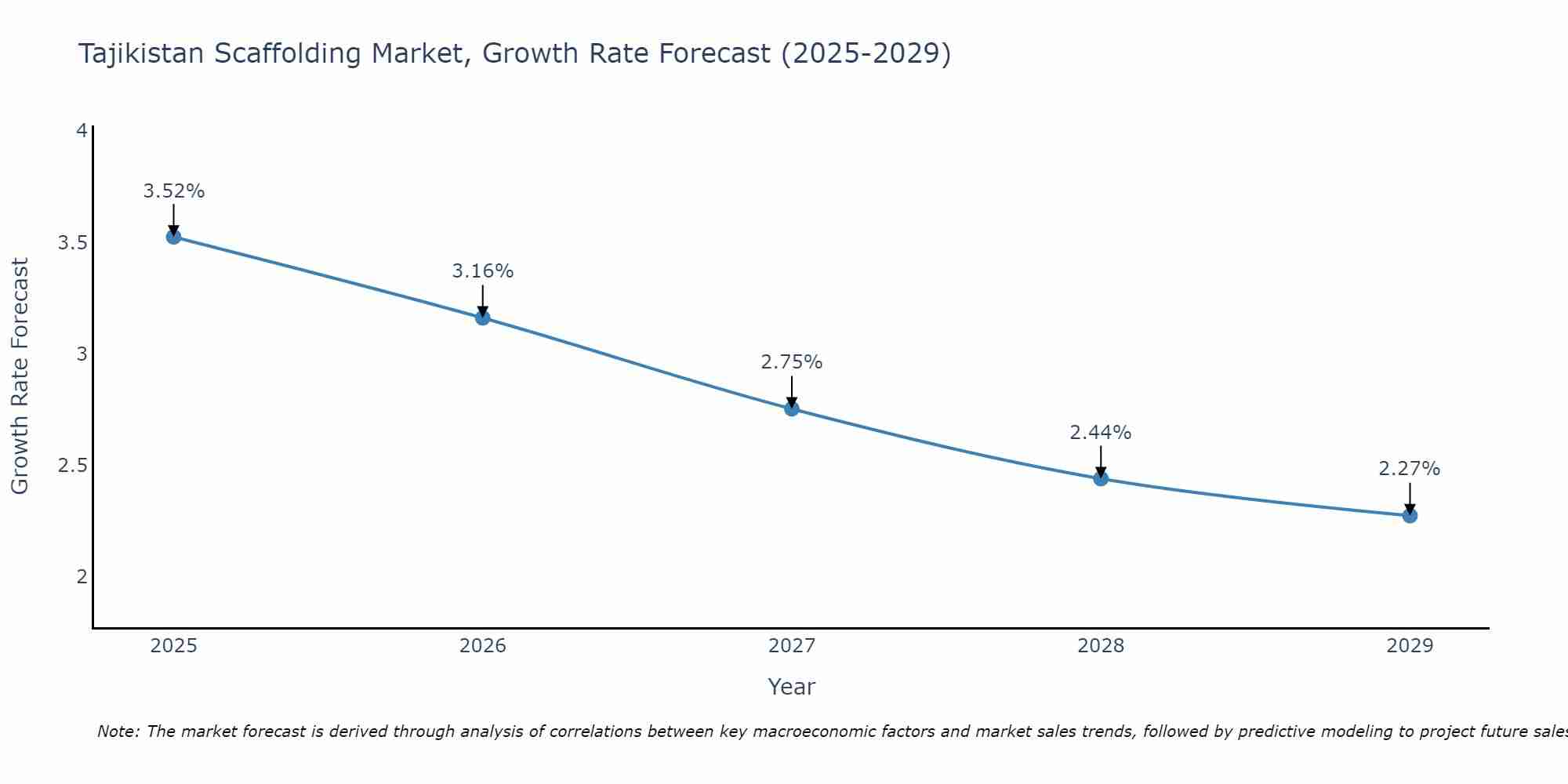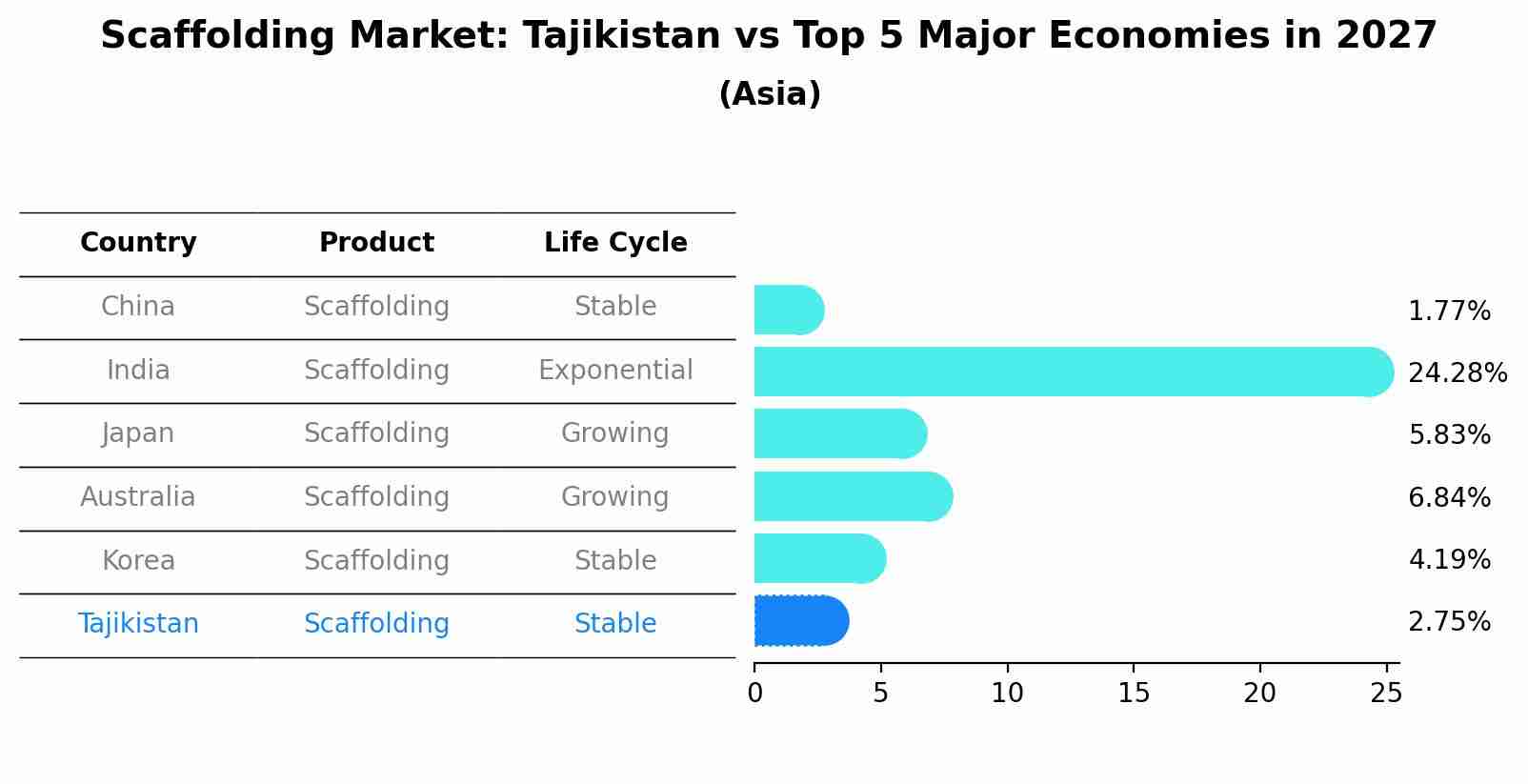Tajikistan Scaffolding Market Outlook | Companies, Size, Forecast, Trends, Share, COVID-19 IMPACT, Growth, Industry, Value, Analysis & Revenue
| Product Code: ETC377819 | Publication Date: Aug 2022 | Updated Date: Jul 2025 | Product Type: Market Research Report | |
| Publisher: 6Wresearch | Author: Summon Dutta | No. of Pages: 75 | No. of Figures: 35 | No. of Tables: 20 |
Tajikistan Scaffolding Market Size Growth Rate
The Tajikistan Scaffolding Market may undergo a gradual slowdown in growth rates between 2025 and 2029. Beginning strongly at 3.52% in 2025, growth softens to 2.27% in 2029.

Scaffolding Market: Tajikistan vs Top 5 Major Economies in 2027 (Asia)
Tajikistan's Scaffolding market is anticipated to experience a stable growth rate of 2.75% by 2027, reflecting trends observed in the largest economy China, followed by India, Japan, Australia and South Korea.

Tajikistan Scaffolding Market Synopsis
The Tajikistan scaffolding market is experiencing steady growth driven by increasing construction activities in the country. The demand for scaffolding is primarily fueled by the expansion of infrastructure projects, commercial developments, and residential construction. The market is witnessing a shift towards safer and more efficient scaffolding solutions, leading to a higher adoption of advanced materials and technology. Key players in the market are focusing on providing durable and cost-effective scaffolding products to cater to the evolving needs of the construction industry in Tajikistan. Government initiatives to improve building standards and safety regulations are also influencing market trends. Overall, the Tajikistan scaffolding market is poised for further growth as the construction sector continues to expand.
Tajikistan Scaffolding Market Trends
The Tajikistan scaffolding market is witnessing a steady growth due to ongoing construction projects across the country, driven by infrastructure development and urbanization. There is a growing demand for advanced and durable scaffolding systems that ensure safety and efficiency at construction sites. The market is also seeing a shift towards eco-friendly and sustainable scaffolding materials in line with global environmental concerns. Additionally, the adoption of digital technologies such as Building Information Modeling (BIM) is becoming more prevalent in the scaffolding sector in Tajikistan, enabling better project planning and coordination. Overall, the market is expected to continue expanding as construction activity remains robust in the country, creating opportunities for both local and international scaffolding companies to cater to the growing needs of the construction industry.
Tajikistan Scaffolding Market Challenges
In the Tajikistan scaffolding market, several challenges exist. Limited availability of skilled labor and trained professionals for erecting and dismantling scaffolding structures poses a significant obstacle. Additionally, the market faces issues related to the lack of standardized safety regulations and enforcement measures, leading to potential safety hazards for workers. Import restrictions and high tariffs on scaffolding materials also contribute to higher costs for companies operating in the market. Furthermore, the overall economic and political instability in the region can impact investment decisions and project timelines, affecting the demand for scaffolding services. Addressing these challenges through increased training programs, improved safety regulations, and trade policies could help boost the growth and efficiency of the scaffolding market in Tajikistan.
Tajikistan Scaffolding Market Investment Opportunities
The Tajikistan scaffolding market presents promising investment opportunities due to the country`s growing construction sector driven by infrastructure development projects. Investors can consider opportunities in supplying various types of scaffolding materials and services such as steel and aluminum scaffolding systems, accessories, and rental services. With the government`s focus on improving transportation networks, housing, and industrial facilities, the demand for scaffolding solutions is expected to rise. Additionally, foreign investors can leverage partnerships with local construction companies to expand their market presence and capitalize on the increasing demand for high-quality scaffolding products. It is essential for investors to conduct thorough market research, understand regulatory requirements, and establish strong partnerships to successfully navigate and capitalize on the Tajikistan scaffolding market.
Jordan Agar Market Government Policies
Government policies in Tajikistan related to the scaffolding market focus on ensuring safety standards and regulations are met to protect workers and the public. The State Committee on Construction and Architecture oversees the implementation of construction regulations, including requirements for scaffolding structures to meet specific safety criteria. Companies operating in the scaffolding market must adhere to these regulations to obtain necessary permits and licenses for their projects. Additionally, the government encourages the use of locally manufactured scaffolding materials to support domestic industries and reduce reliance on imports. Overall, the government`s policies aim to promote safe construction practices, support local industries, and ensure compliance with regulatory standards in the Tajikistan scaffolding market.
Tajikistan Scaffolding Market Future Outlook
The future outlook for the Tajikistan Scaffolding Market appears promising, driven by ongoing infrastructure development projects and a growing construction industry in the country. The government`s focus on improving transportation networks, building residential complexes, and enhancing industrial facilities will continue to boost the demand for scaffolding solutions. Furthermore, the increasing adoption of safety regulations and standards in construction practices will further drive the market growth as scaffolding is essential for ensuring worker safety. With a favorable economic environment and a rising number of construction projects in the pipeline, the Tajikistan Scaffolding Market is expected to experience steady growth in the coming years, presenting opportunities for both domestic and international scaffolding providers to capitalize on the market potential.
Key Highlights of the Report:
- Tajikistan Scaffolding Market Outlook
- Market Size of Tajikistan Scaffolding Market, 2021
- Forecast of Tajikistan Scaffolding Market, 2031
- Historical Data and Forecast of Tajikistan Scaffolding Revenues & Volume for the Period 2018 - 2031
- Tajikistan Scaffolding Market Trend Evolution
- Tajikistan Scaffolding Market Drivers and Challenges
- Tajikistan Scaffolding Price Trends
- Tajikistan Scaffolding Porter's Five Forces
- Tajikistan Scaffolding Industry Life Cycle
- Historical Data and Forecast of Tajikistan Scaffolding Market Revenues & Volume By Type for the Period 2018 - 2031
- Historical Data and Forecast of Tajikistan Scaffolding Market Revenues & Volume By Supported Scaffolding for the Period 2018 - 2031
- Historical Data and Forecast of Tajikistan Scaffolding Market Revenues & Volume By Suspended Scaffolding for the Period 2018 - 2031
- Historical Data and Forecast of Tajikistan Scaffolding Market Revenues & Volume By Rolling Scaffolding for the Period 2018 - 2031
- Historical Data and Forecast of Tajikistan Scaffolding Market Revenues & Volume By Material for the Period 2018 - 2031
- Historical Data and Forecast of Tajikistan Scaffolding Market Revenues & Volume By Aluminum for the Period 2018 - 2031
- Historical Data and Forecast of Tajikistan Scaffolding Market Revenues & Volume By Wood for the Period 2018 - 2031
- Historical Data and Forecast of Tajikistan Scaffolding Market Revenues & Volume By Steel for the Period 2018 - 2031
- Historical Data and Forecast of Tajikistan Scaffolding Market Revenues & Volume By End User for the Period 2018 - 2031
- Historical Data and Forecast of Tajikistan Scaffolding Market Revenues & Volume By Residential for the Period 2018 - 2031
- Historical Data and Forecast of Tajikistan Scaffolding Market Revenues & Volume By Commercial for the Period 2018 - 2031
- Historical Data and Forecast of Tajikistan Scaffolding Market Revenues & Volume By Industrial for the Period 2018 - 2031
- Tajikistan Scaffolding Import Export Trade Statistics
- Market Opportunity Assessment By Type
- Market Opportunity Assessment By Material
- Market Opportunity Assessment By End User
- Tajikistan Scaffolding Top Companies Market Share
- Tajikistan Scaffolding Competitive Benchmarking By Technical and Operational Parameters
- Tajikistan Scaffolding Company Profiles
- Tajikistan Scaffolding Key Strategic Recommendations
Frequently Asked Questions About the Market Study (FAQs):
- Single User License$ 1,995
- Department License$ 2,400
- Site License$ 3,120
- Global License$ 3,795
Search
Related Reports
- ASEAN Bearings Market (2025-2031) | Strategy, Consumer Insights, Analysis, Investment Trends, Opportunities, Growth, Size, Share, Industry, Revenue, Segments, Value, Segmentation, Supply, Forecast, Restraints, Outlook, Competition, Drivers, Trends, Demand, Pricing Analysis, Competitive, Strategic Insights, Companies, Challenges
- Europe Flooring Market (2025-2031) | Outlook, Share, Industry, Trends, Forecast, Companies, Revenue, Size, Analysis, Growth & Value
- Saudi Arabia Manlift Market (2025-2031) | Outlook, Size, Growth, Trends, Companies, Industry, Revenue, Value, Share, Forecast & Analysis
- Uganda Excavator, Crane, and Wheel Loaders Market (2025-2031) | Strategy, Consumer Insights, Analysis, Investment Trends, Opportunities, Growth, Size, Share, Industry, Revenue, Segments, Value, Segmentation, Supply, Forecast, Restraints, Outlook, Competition, Drivers, Trends, Demand, Pricing Analysis, Competitive, Strategic Insights, Companies, Challenges
- Rwanda Excavator, Crane, and Wheel Loaders Market (2025-2031) | Strategy, Consumer Insights, Analysis, Investment Trends, Opportunities, Growth, Size, Share, Industry, Revenue, Segments, Value, Segmentation, Supply, Forecast, Restraints, Outlook, Competition, Drivers, Trends, Demand, Pricing Analysis, Competitive, Strategic Insights, Companies, Challenges
- Kenya Excavator, Crane, and Wheel Loaders Market (2025-2031) | Strategy, Consumer Insights, Analysis, Investment Trends, Opportunities, Growth, Size, Share, Industry, Revenue, Segments, Value, Segmentation, Supply, Forecast, Restraints, Outlook, Competition, Drivers, Trends, Demand, Pricing Analysis, Competitive, Strategic Insights, Companies, Challenges
- Angola Excavator, Crane, and Wheel Loaders Market (2025-2031) | Strategy, Consumer Insights, Analysis, Investment Trends, Opportunities, Growth, Size, Share, Industry, Revenue, Segments, Value, Segmentation, Supply, Forecast, Restraints, Outlook, Competition, Drivers, Trends, Demand, Pricing Analysis, Competitive, Strategic Insights, Companies, Challenges
- Israel Intelligent Transport System Market (2025-2031) | Strategy, Consumer Insights, Analysis, Investment Trends, Opportunities, Growth, Size, Share, Industry, Revenue, Segments, Value, Segmentation, Supply, Forecast, Restraints, Outlook, Competition, Drivers, Trends, Demand, Pricing Analysis, Competitive, Strategic Insights, Companies, Challenges
- Uganda Precast and Aggregate Market (2025-2031) | Strategy, Consumer Insights, Analysis, Investment Trends, Opportunities, Growth, Size, Share, Industry, Revenue, Segments, Value, Segmentation, Supply, Forecast, Restraints, Outlook, Competition, Drivers, Trends, Demand, Pricing Analysis, Competitive, Strategic Insights, Companies, Challenges
- Australia IT Asset Disposal Market (2025-2031) | Strategy, Consumer Insights, Analysis, Investment Trends, Opportunities, Growth, Size, Share, Industry, Revenue, Segments, Value, Segmentation, Supply, Forecast, Restraints, Outlook, Competition, Drivers, Trends, Demand, Pricing Analysis, Competitive, Strategic Insights, Companies, Challenges
Industry Events and Analyst Meet
Our Clients
Whitepaper
- Middle East & Africa Commercial Security Market Click here to view more.
- Middle East & Africa Fire Safety Systems & Equipment Market Click here to view more.
- GCC Drone Market Click here to view more.
- Middle East Lighting Fixture Market Click here to view more.
- GCC Physical & Perimeter Security Market Click here to view more.
6WResearch In News
- Doha a strategic location for EV manufacturing hub: IPA Qatar
- Demand for luxury TVs surging in the GCC, says Samsung
- Empowering Growth: The Thriving Journey of Bangladesh’s Cable Industry
- Demand for luxury TVs surging in the GCC, says Samsung
- Video call with a traditional healer? Once unthinkable, it’s now common in South Africa
- Intelligent Buildings To Smooth GCC’s Path To Net Zero













